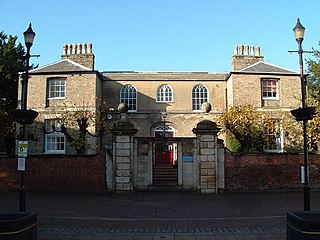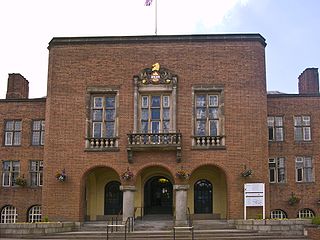Related Research Articles

Wisbech is a market town, inland port and civil parish in the Fenland district in Cambridgeshire, England. In 2011 it had a population of 31,573. The town lies in the far north-east of Cambridgeshire, bordering Norfolk and only 5 miles (8 km) south of Lincolnshire. The tidal River Nene running through the town is spanned by two road bridges. Wisbech is in the Isle of Ely and has been described as "the Capital of The Fens".

Fenland is a local government district in Cambridgeshire, England. It was historically part of the Isle of Ely. The district covers around 500 square kilometres (190 sq mi) of mostly agricultural land in the extremely flat Fens. The council is based in Fenland Hall, in March. Other towns include Chatteris, Whittlesey and Wisbech, the largest of the four.

Bromley was a local government district in northwest Kent from 1867 to 1965 around the town of Bromley. The area was suburban to London, and formed part of the Metropolitan Police District and from 1933 was included in the area of the London Passenger Transport Board.

Wisbech Grammar School is an 11–18 co-educational, Church of England, private day school and sixth form in Wisbech, Isle of Ely, Cambridgeshire, England. Founded by the Guild of the Holy Trinity in 1379, it is one of the oldest schools in the country.

Wisbech was a rural district in Cambridgeshire in England from 1894 to 1974.

Wisbech Castle was a stone to motte-and-bailey castle built to fortify Wisbech on the orders of William I in 1072, it probably replaced an earlier timber and turf complex. The layout was probably oval in shape and size, on the line still marked by the Circus. The original design and layout is unknown. It was rebuilt in stone in 1087. The castle was reputedly destroyed in a flood in 1236. In the 15th century, repairs were becoming too much for the ageing structure, and a new building was started in 1478 under John Morton, Bishop of Ely. His successor, John Alcock, extended and completed the re-building and died in the Castle in 1500. Subsequent bishops also spent considerable sums on this new palace. The Bishop's Palace was built of brick with dressings of Ketton Stone, but its exact location is unknown.
Cambridgeshire is a former Parliamentary constituency in the United Kingdom. It was a constituency represented by two Members of Parliament in the House of Commons of the Parliament of England then in the Parliament of Great Britain from 1707 to 1800 and in the Parliament of the United Kingdom from 1801 to 1832, when its representation was increased to three until it was abolished in 1885.
Wisbech is a former United Kingdom Parliamentary constituency. It was created upon the abolition of an undivided Cambridgeshire county constituency in 1885 and was itself abolished in 1918.

The Cambridgeshire Regiment was an infantry regiment of the British Army, and was part of the Territorial Army. Originating in units of rifle volunteers formed in 1860, the regiment served in the Second Anglo-Boer War and the First and Second World Wars before losing its separate identity in 1961. Its lineage is continued today by the Royal Anglian Regiment. The regiment and men are often referred to as the Fen Tigers.

The Wisbech Canal was a broad canal from Wisbech, Isle of Ely in the Fenland area of Cambridgeshire, England. It ran from the River Nene at Wisbech to the Well Creek at Outwell now in Norfolk, which gave access to the River Great Ouse. It was abandoned in 1926 and filled in during the 1970s.

Walsoken is a settlement and civil parish in Norfolk, England, which is conjoined as a suburb at the northeast of the town of Wisbech, Isle of Ely, Cambridgeshire.

Carlisle was, from 1835 to 1974, a local government district in the northwest of England, coterminate with Carlisle. In 1835, following the Municipal Corporations Act 1835, Carlisle was constituted a municipal borough of Cumberland, but was promoted to county borough status in 1914, within its boundaries taking over the functions of Cumberland County Council. The district was abolished on 31 March 1974 by the Local Government Act 1972.

Alexander Peckover, 1st Baron Peckover LL FRGS, FSA, FLS, was an English Quaker banker, philanthropist and collector of ancient manuscripts.

The Mayor of South Molton in Devon is an ancient historical office which survives at the present time. In the Middle Ages the town of South Molton was incorporated by royal charter into a borough governed by a mayor and Corporation. This enabled the inhabitants to free themselves from the jurisdiction of the lord of the manor of South Molton and to subject themselves instead to the jurisdiction of the king.

The Mayor of Dudley is an office held by a councillor of the Metropolitan Borough of Dudley. The post is partly ceremonial although the mayor does also preside over full meetings of the council and has the duty of holding decision makers to account. The mayor is elected by fellow councillors in May of each year. Before 1865, when the municipal borough was incorporated, the position was associated with the Court Leet of the Lords of Dudley, which governed the borough of Dudley from at least the middle of the 16th century and probably from the Middle Ages. The earliest known mayor, John A’Parke was selected in 1565.

Alderman Richard Young,, was a British merchant, shipowner and Liberal politician.

Wisbech Town Hall is a historic building on North Brink, Wisbech, Isle of Ely, Cambridgeshire, England. The building incorporates the offices, council chamber and mayor's parlour of Wisbech Town Council, and is a Grade II listed building.
Wisbech Town Council is a parish council covering the town of Wisbech in England. It is the successor to the Wisbech Municipal Borough. The Council is based at 1 North Brink, Wisbech where its committee meetings and full council meetings are usually held.

The mayor of Wrexham is the civic figurehead and first citizen of the city of Wrexham, and Wrexham County Borough in the north of Wales. The position is elected by members of Wrexham County Borough Council at their annual meeting, and today, holders of the position mainly serve a one-year term. The position is currently held by Councillor Beryl Blackmore of Marford and Hoseley for the 2024/2025 term.
References
- ↑ "THE TOWN COUNCIL". Huntingdon, Bedford & Peterborough Gazette. 6 February 1836. p. 2.
- ↑ "Wisbech (Municipal Borough Limits)". Cambridge Independent Press. 27 June 1874. p. 8.
- ↑ "Wisbech RD through time: Census tables with data for the Local Government District". A Vision of Britain through Time. GB Historical GIS / University of Portsmouth. Retrieved 15 June 2017.
- ↑ "Wisbech: Introduction". Victoria County History. British History Online. 2002. Retrieved 15 June 2017.
- ↑ "Freedom". Lynn Advertiser. 22 March 1974. p. 33.
- ↑ "Chamber guide" (PDF). www.wisbechtowncouncil.gov.uk.
- ↑ RB Pugh (1953). The Victoria County History of the county of Cambridge and the Isle of Ely. Vol. 4. OUP. p. 256.
- ↑ "Regalia" (PDF). www.wisbechtowncouncil.gov.uk. Retrieved 18 May 2021.
- ↑ "Lord Peckover's Handsome Gift". Norfolk News. 16 November 1907. p. 8.
- ↑ "Presentation of a silver cradle". Norfolk News. 14 September 1861. p. 6.
- ↑ "The Radical Town Council". Lynn Advertiser. 14 November 1868. p. 5.
- ↑ "Wisbech Town Council". Cambridge Independent Press. 13 November 1869. p. 7.
- ↑ "Roll of the freemen of wisbech". www.wisbechtowncouncil.gov.uk. 12 February 2019. Retrieved 18 May 2021.